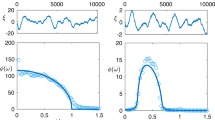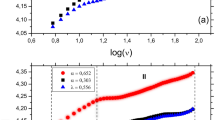Abstract
The dynamical processes underlying evolution over geological timescales remain unclear1,2. Analyses of time series of the fossil record have highlighted the possible signature of periodicity in mass extinctions3,4, perhaps owing to external influences such as meteorite impacts. More recently the fluctuations in the evolutionary record have been proposed to result from intrinsic nonlinear dynamics for which self-organized criticality provides an appropriate theoretical framework5,6,7. A consequence of this controversial8 conjecture is that the fluctuations should be self-similar, exhibiting scaling behaviour like that seen in other biological9 and socioeconomic10,11 systems. The self-similar character is described by a 1/f power spectrum P(f), which measures the contributions of each frequency f to the overall time series. If self-similarity is present, then P(f) ≈ f− β with 0 < β <2. This idea has not been sufficiently tested, however, owing to a lack of adequate data. Here we explore the statistical fluctuation structure of several time series obtained from available palaeontological data bases, particularly the new ‘Fossil Record 2’18. We find that these data indeed show self-similar fluctuations characterized by a 1/f spectrum. These findings support the idea that a nonlinear response of the biosphere to perturbations provides the main mechanism for the distribution of extinction events.
This is a preview of subscription content, access via your institution
Access options
Subscribe to this journal
Receive 51 print issues and online access
$199.00 per year
only $3.90 per issue
Buy this article
- Purchase on Springer Link
- Instant access to full article PDF
Prices may be subject to local taxes which are calculated during checkout



Similar content being viewed by others
References
Chaloner, W. & Hallam, A. (eds) Evolution and extinction. Phil. Trans. R. Soc. Lond. B 325, 239–488 (1989).
Benton, M. J. Diversification and extinction in the history of life. Science 268, 52–58 (1995).
Raup, D. M. Akill curve for Phanerozoic marine species. Paleobiology 17, 37–48 (1991).
Raup, D. M. & Sepkoski, J. J. J Periodicity of extinctions in the geologic past. Proc. Natl Acad. Sci. USA 81, 801–805 (1994).
Bak, P. & Snepen, K. Punctuated equilibrium and criticality in a simple model of evolution. Phys. Rev. Lett. 59, 381–384 (1993).
Kauffman, S. & Johnsen, J. Coevolution to the edge of chaos: coupled fitness landscapes, poised states and coevolutionary avalanches. J. Theor. Biol. 149, 467–505 (1991).
Solé, R. V. & Manrubia, S. C. Extinction and selforganized criticality in a model of large-scale evolution. Phys. Rev. 54, R42–R45 (1996).
Maddox, J. Punctuated equilibrium on a computer. Nature 371, 197 (1994).
Schroeder, M. Fractals, Chaos, Power Laws(Freeman, New York, (1991)).
Stanley, H. H.et al. Scaling and universality in animate and inanimate systems. Physica A A231, 20–48 (1996).
Mandelbrot, B. B. The variation of certain speculative prices. J. Bus. Univ. Chicago 36, 307–317 (1963).
Solé, R. V. & Bascompte, J. Are critical phenomena relevant to large-scale evolution? Proc. R. Soc. Lond. B 263, 161–168 (1996).
Jablonski, D. Extinctions in the fossil record. Phil. Trans. R. Soc. Lond. B 344, 11–17 (1994).
Raup, D. Extinctions: Bad Genes or Bad Luck?(Oxford Univ. Press, (1993)).
Elliott, D. K. (ed.) Dynamics of Extinction(Wiley, New York, (1986)).
House, M. R. Ammonoid extinction events. Phil. Trans. R. Soc. Lond. B 325, 307–326 (1989).
Newman, M. E. J. Self-organized criticality, evolution and the fossil extinction record. Proc. R. Soc. Lond. B 263, 1605–1610 (1996).
Benton, M. J. (ed.) The Fossil Record 2(Chapman & Hall, London, (1993)).
Sepkoski, J. J. in Pattern and Process in the History of Life(eds Ramp, D. & Jablonski, D.) 277–295 (Springer, Berlin, (1986)).
Davis, J. C. Statistics and Data Analysis in Geology(Wiley, New York, (1973)).
Korvin, G. Fractal Models in the Earth Sciences(Elsevier, (1992)).
Sepkoski, J. J. & Raup, D. in Dynamics of Extinctions(ed. Elliott, D. K.) Ch. 2 (Wiley, New York, (1986)).
Mandelbrot, B. B. The Fractal Geometry of Nature(Freeman, New York, (1982)).
Sugihara, G. & May, R. M. Applications of fractals in ecology. Trends Ecol. Evol. 5, 79–86 (1990).
Stanley, H. H.et al. Statistical mechanics in biology: how ubiquitous are long-range correlations? Physica A 205, 214–253 (1996).
Plotnick, R. E. & McKinney, M. Evidence of self-organization in planktic foraminiferal evolution: implications for interconnectedness of paleoecosystems. Palaios 8, 202–212 (1993).
Burlando, B. The fractal geometry of evolution. J. Theor. Biol. 163, 161–172 (1993).
Solé, R. V., Bascompte, J. & Manrubia, S. C. Extinctions: Bad genes or weak chaos? Proc. R. Soc. Lond. B 263, 1407–1413 (1996).
Raup, D. M. & Sepkoski, J. J. J Mass extinctions and the marine fossil record. Science 215, 1501–1503 (1982).
Glen, W. (ed.) The Mass Extinction Debates(Stanford Univ. Press, (1984)).
Sepkoski, J. J. J Akinetic model of Phanerozoic taxonomic diversity III. Post-Paleozoic families and mass extinctions. Paleobiology 10, 246–267 (1984).
Newman, M. E. J. A Model of Mass Extinction(Wkg Pap. 97-02-013 Santa Fe Institute, (1997)); J. Theor. Biol.(in the press).
Signor, P. W. & Lipps, J. H. Sampling bias, gradual extinction patterns and catastrophes in the fossil record. Geol. Soc. Am. Spec. Pap. 190, 291–296 (1982).
Acknowledgements
We thank J. Bascompte, M. Newman, J. Pérez-Mercader, C. Patterson, B. Goodwin, S. Kauffman, K. Sneppen. T. Keitt, J. Sepkoski and M. Gell-Mann for help at different stages of this work and for discussions. This work was supported by DGYCIT (R.V.S. and S.C.M.), CIRIT (S.C.M.), a Leverhulme grant (M.J.B.), the division of Materials Science (P.B.) and the Santa Fe Institute (R.V.S. and P.B.).
Author information
Authors and Affiliations
Corresponding author
Rights and permissions
About this article
Cite this article
Solé, R., Manrubia, S., Benton, M. et al. Self-similarity of extinction statistics in the fossil record. Nature 388, 764–767 (1997). https://doi.org/10.1038/41996
Issue Date:
DOI: https://doi.org/10.1038/41996
This article is cited by
-
Does Species Evolution Follow Scale Laws? First Applications of the Scale Relativity Theory to Fossil and Living-beings
Foundations of Science (2010)
-
A new approach for rescaling land cover data
Landscape Ecology (2008)
-
Tunable scaling behaviour observed in Barkhausen criticality of a ferromagnetic film
Nature Physics (2007)
-
Scaling and correlation of atmospheric acid deposition evolutions
Stochastic Environmental Research and Risk Assessment (2006)
Comments
By submitting a comment you agree to abide by our Terms and Community Guidelines. If you find something abusive or that does not comply with our terms or guidelines please flag it as inappropriate.



